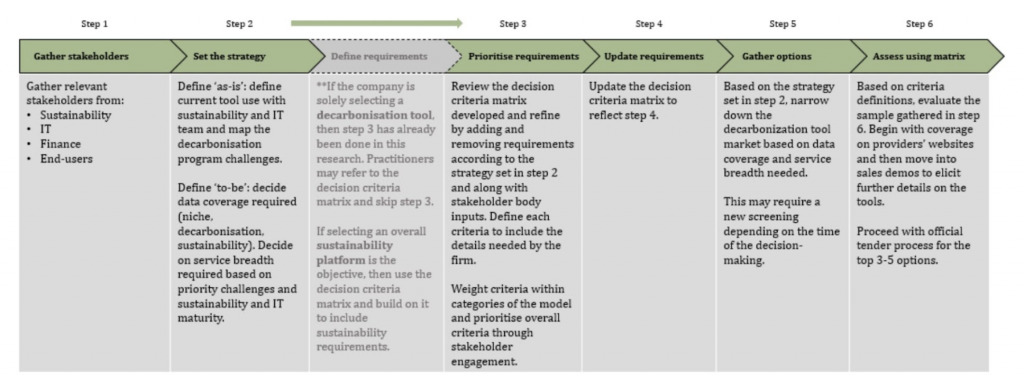By Kamil Raad, Jackie Hwang and Prof. Kristjan Jespersen
Companies today are facing growing pressure to decarbonise from consumers, investors and regulators. Data management is key to this process as companies need to map their current emissions and monitor and report on these over time. As decarbonisation and sustainability more broadly affect multiple areas of a firm, the sheer volume of data can prove overwhelming—becoming a real challenge for companies. This has driven the proliferation of decarbonisation and sustainability management softwares that promise to solve the challenges companies are facing. However, with over 60 options on the market, selecting the right tool can be a challenge in and of itself. This article outlines an approach for companies to methodically approach tool selection and highlights the importance and need for companies to align their sustainability data governance and IT strategy. The findings are the outcome of a master thesis written for the MSc Business Administration and eBusiness program, under the supervision of Dr. Kristjan Jespersen.
To select a sustainability management tool, companies are recommended to follow the seven step IT procurement process shown below. For a decarbonisation tool, six steps can be followed along with requirements that were defined with practitioners across 10 industries – found at the end of this article.

Figure 1: Six-step decarbonisation tool selection process. Research Outcome.
To start the selection process, a body of stakeholders needs to be gathered which encapsulates all areas of the decision to ensure blind spots are covered. This includes the sustainability, IT and finance teams as well as end-users. The stakeholder body will participate in all subsequent steps of the process. Once gathered, the decision-making body can form the strategy for the tool, including mapping the current state of tool usage in the company, and the challenges faced in the existing sustainability processes. Based on this, a “to-be” state can be defined which will guide what is needed from the tool. The strategy will guide steps 3, 4, and 5 as requirements can be defined or prioritized based on the company’s objectives. Finally, tool options can be gathered and assessed – first using desk research, followed by sales demos and market dialogues with providers. Once done, a shortlist of candidates can be defined and official IT tender processes can be followed.
While the process may appear somewhat straightforward, the steps need to be approached diligently to ensure all the right criteria are considered. Further, a particularly crucial step in the process is setting the strategy for the tool. As it stands, this is an underdeveloped area in both practice and academia. In academia, little guidance exists on how this alignment should take shape or how it should be approached by companies. In practice, the lack of resources, the novelty of the area and the need to act quickly are driving companies to overlook strategy setting, instead opting for quick decisions. While this can be beneficial in the short term, it can limit the process efficiencies gained over the long term, as certain needs go overlooked and companies end up needing to change tools frequently. By following a structured process, strategy setting can be done quickly and effectively. Companies that do this will gain an advantage as they will not only ensure they select the right tool for the short term but also one that aligns with their deeply rooted sustainability and decarbonisation challenges.
As managing sustainability and decarbonisation data continues to grow in importance, companies need to stay aware of the tool landscape and approach decision-making in a structured manner. This will be crucial to enable well informed decisions that allow companies to maximize their tool’s utility and drive process improvements. Ultimately, this should drive improvements in the way companies manage their decarbonisation and sustainability targets. Nevertheless, for this to work as intended, greater attention needs to be placed on aligning sustainability data governance and IT strategy within the company, and both practice and academia still need to develop in this respect.

Figure 2: Decarbonisation tool selection criteria. Research outcome based on 16 practitioner interviews.
About the Authors
Kamil Raad recently completed his master’s degree in Business Administration and eBusiness from CBS where his research during the degree centred around the use of technology to support sustainability objectives. He was formerly an ESG Research Assistant at the Copenhagen Business School (CBS) under Prof. Kristjan Jespersen. Kamil is currently working in the Strategic Sustainability Consulting department in Ramboll Management Consulting, helping companies with a vast range of sustainability topics.
Jackie Hwang recently completed her master’s degree in Business Administration and eBusiness from CBS. She is currently working in Deloitte’s Digital Strategy Consulting department, helping organisations leverage technology to support business goals. She is passionate about sustainability and making an impact to help businesses use technology to become more efficient and sustainable.
Prof. Kristjan Jespersen is an Associate Professor in Sustainable Innovation and Entrepreneurship at the Copenhagen Business School (CBS). Kristjan is an Associate Professor at the Copenhagen Business School (CBS). As a primary area of focus, he studies the growing development and management of Ecosystem Services in developing countries. Within the field, Kristjan focuses his attention on the institutional legitimacy of such initiatives and the overall compensation tools used to ensure compliance. He has a background in International Relations and Economics.